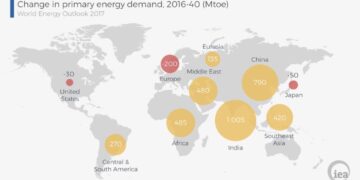The exponential growth of renewable energy is pushing down global electricity prices and helping remove so much carbon from power systems that fossil fuels are no longer economical, and their use has peaked, according to a report.
Author of the article:
Bloomberg News
Priscila Azevedo Rocha
Published Jul 12, 2023 • 2 minute read
 High tension power lines in Shanghai, China, on Friday, June 23, 2023. Extreme weather is already promising a fresh test of the electricity grid just months after heat waves and drought throttled hydropower and triggered widespread power shortages. Photographer: Qilai Shen/Bloomberg Photo by Qilai Shen /Bloomberg
High tension power lines in Shanghai, China, on Friday, June 23, 2023. Extreme weather is already promising a fresh test of the electricity grid just months after heat waves and drought throttled hydropower and triggered widespread power shortages. Photographer: Qilai Shen/Bloomberg Photo by Qilai Shen /Bloomberg
(Bloomberg) — The exponential growth of renewable energy is pushing down global electricity prices and helping remove so much carbon from power systems that fossil fuels are no longer economical, and their use has peaked, according to a report.
Advertisement 2
This advertisement has not loaded yet, but your article continues below.
THIS CONTENT IS RESERVED FOR SUBSCRIBERS ONLY
Subscribe now to read the latest news in your city and across Canada.
Exclusive articles by Kevin Carmichael, Victoria Wells, Jake Edmiston, Gabriel Friedman and others. Daily content from Financial Times, the world’s leading global business publication. Unlimited online access to read articles from Financial Post, National Post and 15 news sites across Canada with one account. National Post ePaper, an electronic replica of the print edition to view on any device, share and comment on. Daily puzzles, including the New York Times Crossword.
SUBSCRIBE TO UNLOCK MORE ARTICLES
Subscribe now to read the latest news in your city and across Canada.
Exclusive articles by Kevin Carmichael, Victoria Wells, Jake Edmiston, Gabriel Friedman and others. Daily content from Financial Times, the world’s leading global business publication. Unlimited online access to read articles from Financial Post, National Post and 15 news sites across Canada with one account. National Post ePaper, an electronic replica of the print edition to view on any device, share and comment on. Daily puzzles, including the New York Times Crossword.
REGISTER TO UNLOCK MORE ARTICLES
Create an account or sign in to continue with your reading experience.
Access articles from across Canada with one account. Share your thoughts and join the conversation in the comments. Enjoy additional articles per month. Get email updates from your favourite authors.
From China to Europe, the capacities of solar, battery and wind power are surging, the Rocky Mountain Institute said in an analysis released Thursday in conjunction with the Bezos Earth Fund. That means the world’s grid should be able to deliver on its net zero targets by 2030 — sending the demand for gas, oil and coal into free fall.
Article content
“Fossil-fuel demand in the electricity system, specifically, has clearly peaked in 2022,” Kingsmill Bond, senior principal at RMI, told reporters. Moving forward, it’s “very hard actually for fossil-fuel demand to grow from these levels simply because of the speed of which these alternative technologies grow.”
The shift comes as governments and industries rebuild their energy infrastructure following supply shortages and skyrocketing prices in the wake of Russia’s invasion of Ukraine. The high rates of deployment also are driving down prices for renewables, rendering higher cost hydrocarbons uncompetitive.
This advertisement has not loaded yet, but your article continues below.
Article content
Solar Beats Coal in Europe for First Time – But There’s a Glitch
Solar panels and wind turbines will supply more than a third of global electricity by 2030, compared with about 12% today, the RMI forecasts. Those sources should produce as much as 14,000 terawatt-hours, overtaking fossil fuels.
While China and Europe lead the growth in clean energy, deployment is reaching other parts of the globe. Namibia, the Netherlands, Palestine, Jordan and Chile have boosted solar and wind generation at sufficient rates for five years, the report said.
Renewables are already considered a cheaper form of electricity, with costs plummeting during the past decade, according to BloombergNEF. Solar and battery costs declined 80% between 2012 and 2022, offshore wind dropped 73% and onshore wind fell 57%, the data show.
The increasing adaptation of clean-tech is set to halve its prices by 2030 — falling to as low as $20 a megawatt-hour for solar from $40-plus now, RMI said.
“Change is happening faster than we think,” Christiana Figueres, an architect of the Paris Agreement on climate, said during a roundtable discussion. “The tripling of renewables by 2030 is not guaranteed but is more possible today than it ever was because of the exponential trends that we are seeing.”
>>> Read full article>>>
Copyright for syndicated content belongs to the linked Source : Financial Post – https://financialpost.com/pmn/business-pmn/fossil-fuel-demand-for-electricity-may-have-peaked-globally















![[News] China Makes Breakthrough in Chip Technology, Paving the Way for Lithography Advancements – TrendForce](https://earth-news.info/wp-content/uploads/2025/11/324664-news-china-makes-breakthrough-in-chip-technology-paving-the-way-for-lithography-advancements-trendforce-360x180.jpg)















